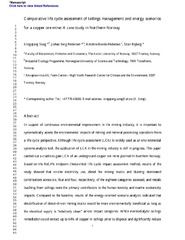| dc.contributor.author | Song, Xingqiang | |
| dc.contributor.author | Pettersen, Johan Berg | |
| dc.contributor.author | Pedersen, Kristine Bondo | |
| dc.contributor.author | Røberg, Stian | |
| dc.date.accessioned | 2018-06-27T11:45:13Z | |
| dc.date.available | 2018-06-27T11:45:13Z | |
| dc.date.issued | 2017-07-05 | |
| dc.description.abstract | In support of continuous environmental improvement in the mining industry, it is important to systematically
assess the environmental impacts of mining and mineral processing operations from a life
cycle perspective. Although life cycle assessment (LCA) is widely used as an environmental systems
analysis tool, the application of LCA in the mining industry is still in progress. This paper carried out a
cradle-to-gate LCA of an underground copper ore mine planned in Northern Norway. Based on the
ReCiPe midpoint (hierarchist) life cycle impact assessment method, results of the study showed that onsite
electricity use, diesel for mining trucks and blasting dominated contributions across six, four and
four, respectively, of the eighteen categories assessed, and metals leaching from tailings were the primary
contributors to the human toxicity and marine ecotoxicity impacts. Compared to the baseline,
results of the energy-oriented scenario analysis indicated that electrification of diesel-driven mining
trucks would be more environmentally beneficial as long as the electrical supply is “relatively clean”
across impact categories. While electrodialytic tailings remediation could extract up to 64% of copper in
tailings prior to disposal and significantly reduce the human toxicity impact of tailings, the marine
ecotoxicity impact of tailings after electrodialysis changed inconsistently across the ReCiPe hierarchist
and egalitarian perspectives. It is recommended to further assess the trade-off between the benefits of
electrodialytic tailings remediation (extracting more copper) and the potential impacts of deposited
tailings after electrodialysis from a multi-criteria decision-analysis perspective. In a generic context, this
study provides an insight in further promoting LCA as an environmental decision-support tool, especially
for comparing available cleaner production options, improving the overall environmental performance of
a mine, and facilitating better communication with stakeholders. | en_US |
| dc.description | Accepted manuscript version. Published version available in <a href= https://doi.org/10.1016/j.jclepro.2017.07.021> Comparative life cycle assessment of tailings management and energy scenarios for a copper ore mine: A case study in Northern Norway (2017), 164, s.892-904. </a> | en_US |
| dc.identifier.citation | Song, X., Pettersen, J.B., Pedersen, K.B.& Røberg, S. (2017). Comparative life cycle assessment of tailings management and energy scenarios for a copper ore mine: A case study in Northern Norway. Journal of Cleaner Production,164, 892-904. https://doi.org/10.1016/j.jclepro.2017.07.021 | en_US |
| dc.identifier.cristinID | FRIDAID 1487306 | |
| dc.identifier.doi | 10.1016/j.jclepro.2017.07.021 | |
| dc.identifier.issn | 0959-6526 | |
| dc.identifier.issn | 1879-1786 | |
| dc.identifier.uri | https://hdl.handle.net/10037/13023 | |
| dc.language.iso | eng | en_US |
| dc.publisher | Elsevier | en_US |
| dc.relation.journal | Journal of Cleaner Production | |
| dc.relation.projectID | info:eu-repo/grantAgreement/RCN/NORDSATS/195160/Norway/Northern Environmental Waste Management//. | en_US |
| dc.rights.accessRights | openAccess | en_US |
| dc.subject | VDP::Mathematics and natural science: 400::Geosciences: 450::Mineralogy, petrology, geochemistry: 462 | en_US |
| dc.subject | VDP::Mathematics and natural science: 400::Geosciences: 450::Mineralogy, petrology, geochemistry: 462 | en_US |
| dc.subject | Life cycle assessment | en_US |
| dc.subject | Copper mining | en_US |
| dc.subject | Energy | en_US |
| dc.subject | Tailings management | en_US |
| dc.subject | Electrokinetic remediation | en_US |
| dc.title | Comparative life cycle assessment of tailings management and energy scenarios for a copper ore mine: A case study in Northern Norway | en_US |
| dc.type | Journal article | en_US |
| dc.type | Tidsskriftartikkel | en_US |
| dc.type | Peer reviewed | en_US |


 English
English norsk
norsk
